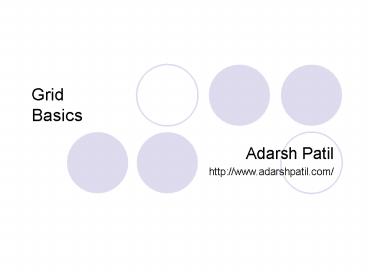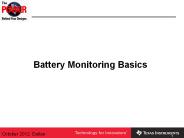Grid Basics - PowerPoint PPT Presentation
1 / 8
Title: Grid Basics
1
Grid Basics
- Adarsh Patil
- http//www.adarshpatil.com/
2
What is Grid ?
- It is a volatile heterogeneous distributed
system. - It is all about sharing resources.
- It integrates all the heterogeneous resources
that are spread across multiple administrative
domains (educational institutions, offices,
industries) across the world. - It gives transparent/collaborative access to
these resources and has distributed Job
management system. - It gives a feeling of Desktop supercomputing -
means you are sitting in front of your desktop
but you are connected to supercomputer. - Grid grows and shrinks dynamically. There is
nothing as such you have a static set of
resources which we call as Grid. - Cluster is not a Grid.
3
What we mean by Grid Resources?
- PCs, Desktops, Workstations, Clusters, Software's
- Cluster of Clusters, Clusters of workstations,
Piles of PCs - Storage elements
- Mainframes, Supercomputers
- Visualization Instruments
- Collaborative Scientists and end users
- Applications
- (we may note here that resources involved in Grid
are heterogeneous. For example different type
of processors Pentium, AMD, PowerPC)
4
Why do we need to build Grid?
- To integrate and aggregate affordable(PC,Desktop,P
rinters) and unaffordable (clusters,supercomputers
,mainframes,giant telescope etc) resources - To provide high throughput
- To build and harvest collaborative boundaries
across various communities in research. - To give the user feeling of using a most powerful
computer. - Make fruitful use of the underlying resources and
make it as a commodity
5
Difference between Grid and Cluster
Characteristics Grid Cluster
System Heterogeneous (Pentium, AMD, PowerPC, Different Operating systems, Multiple owners) Homogeneous (only one kind of processor)
Single system Image No Number of autonomous systems Yes
Job Management System Distributed Centralized
Number of Nodes Ranges from 10s to millions Ranges from 10 to 100k
Fault Tolerance Scheduling Security Everything is distributed, concept of Local resource managers and Resource brokers Centralized scheduling, Fault Tolerance and security.
Software's used Mixture of Open Source and Proprietary Mostly Open Source Software's
Transparent Access It gives transparent access to whatever resources connected. Only access to the nodes of the Cluster and its attached storage.
Computing It is High Throughput Computing (HTC) It is High Performance Computing
Availability Highly Volatile, resource join and leave. No guarantee of quality of Service Highly Available . Good quality of service
6
How can we build a Grid?
- This question has answers within itself . With
respect to Grid this question means How do we
take part in the Grid? - Or
- How do we contribute to the Grid ?
- Or
- How to we use the Grid?
- Grid is a social being.
- Grid is analogous to Electricity Grid. Now if you
ask How do we build Electricity Grid? - Answers may be
- Connect to an existing Grid and use it (as a
user) and contribute (as a resource). - Build a grid using the existing resources using
Grid toolkits , Core Middleware's, User Level
Middleware's. - Getting connected is being part of the Grid.
7
Some Terminology Basics
- Middleware Resource Broker Resource Manager .
- Local Resource Manager - the one which is
installed on a standalone PC / Node. - Core Level Middleware - the one which controls
Local Resource Managers. - Grid Computing large scale Distributed
Computing - Grid computing superset of Cluster computing,
Utility computing, On-demand computing,
Metacomputing, P2P computing. - Testbed - its an infrastructure built out of
commodity or proprietary hardware / software to
test your research ideas, experiments and
activities. Example Practice court for playing
tennis or squash. - Virtual Organizations A community of users
having common research interests and testbed
supporting their interests. For Example a group
of physicists , a group of chemists , a group of
doctors, a group of computer scientists. Each of
these groups forms a Virtual Organization (VO). - Grid has no standard definition. Everyone has
their own definition of Grid. So before jumping
into what a person/company says its big into Grid
Computing, get to know their definition of Grid. - Please keep in mind the basic of everything
remains the same but they change the name and
attach new letters/words to it - Well future is Grid
8
Credits / Acknowledgements
- To all the authors/users/administrators/researcher
s of the Grid Community - Please mail me if you want to make changes or
have any questions - Google and Live are your friends































